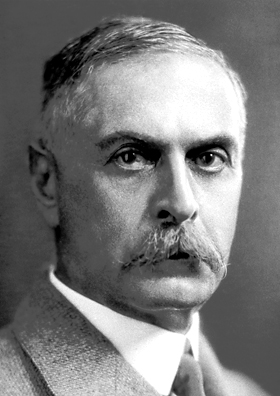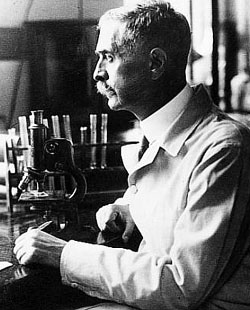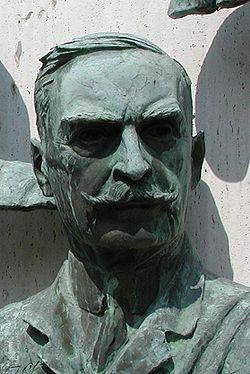<Back to Index>
- Physician Karl Landsteiner, 1868
- Photographer John Thomson, 1837
- Geologist and Experimental Farmer James Hutton, 1726
PAGE SPONSOR



Karl Landsteiner (June 14, 1868 – June 26, 1943), was an Austrian born American biologist and physician. He is noted for having first distinguished the main blood groups in 1901, having developed the modern system of classification of blood groups from his identification of the presence of agglutinins in the blood, and having identified, with Alexander S. Wiener, the Rhesus factor, in 1937, thus enabling physicians to transfuse blood without endangering the patient′s life. With Erwin Popper, he discovered the polio virus, in 1909. In 1930 he received the Nobel Prize in Physiology or Medicine. He was awarded a Lasker Award in 1946 posthumously.
Landsteiner’s father Leopold (1818 – 1875), a renowned Viennese journalist, died at age 56, when Karl was 6. This led to a close relationship between Landsteiner and his mother Fanny (née Hess), (1837 – 1908). He kept her death mask all his life in his bedroom. After graduating with the Matura exam from a Vienna secondary school he took up the study of medicine at the University of Vienna and wrote his doctoral thesis in 1891. While still a student he published an essay on the influence of diets on the composition of blood.
From 1891 to 1893 Landsteiner studied chemistry in Würzburg under Hermann Emil Fischer, München under Eugen Bamberger and Zürich under Arthur Rudolf Hantzsch. A number of publications from that period, some of them in co-operation with his professors, show that he did not restrict himself to hearing lectures.
After returning to Vienna he became an assistant to Max von Gruber at
the Hygienic Institute. In his studies he concentrated on the mechanism
of immunity and the nature of antibodies. From November 1897 to 1908
Landsteiner was an assistant at the pathological - anatomical institute
of the University of Vienna under Anton Weichselbaum,
where he published 75 papers, dealing with issues in serology,
bacteriology, virology and pathological anatomy. In addition he did
some 3,600 autopsies in those ten years. Weichselbaum was Landsteiner’s
tutor for his postdoctoral lecture qualification in 1903. From
1908 to 1920 Landsteiner was prosector at the Wilhelminenspital in
Vienna and in 1911 he was sworn in as an associate professor of
pathological anatomy. During that time he discovered – in co-operation
with Erwin Popper – the infectious character of Poliomyelitis and isolated the polio virus. In
recognition of this groundbreaking discovery, which proved to be the
basis for the fight against polio, he was posthumously inducted into the Polio Hall of Fame at Warm Springs, Georgia, which was dedicated in January 1958.
After World War I,
Vienna and the new republic of Austria as a whole was in a desolate
economic state, a situation in which Landsteiner did not see any
possibilities to carry on with his research work. He decided to move to
Holland and accepted a post as prosector in the small Catholic Ziekenhuis hospital in The Hague and, in order to improve his financial situation also took a job in a small factory, producing old tuberculin (tuberculinum prestinum). He
also published a number of papers, five of them being published in
Dutch by the Royal Academy of Sciences. Yet working conditions proved
to be not much better than in post war Vienna. So Landsteiner accepted
the inivitation that reached him from New York, initiated by Simon Flexner,
who was familiar with Landsteiner's work, to work for the Rockefeller
Institute. With his family he arrived there in the spring of 1923.
Throughout the 1920s Landsteiner worked on the problems of immunity and allergy. In 1927 he discovered new blood groups: M, N and P, refining the work he had begun 20 years before. Soon after Landsteiner and his collaborator, Philip Levine, published the work and, in 1927, the types began to be used in paternity suits.
In the field of bacteriology Landsteiner and Clara Nigg succeeded in 1930 - 1932 in culturing Rickettsia prowazekii, the causative agent of typhus, on living media. Landsteiner
was serving at a war hospital in 1916 when, at the age of 48, he
married Leopoldine Helene Wlasto. Their only child, a son, was born the
following year and was christened Ernst Karl on April 8, 1917. He was
to become a surgeon in Providence, Rhode Island. In 1929 Landsteiner became a United States citizen. Karl Landsteiner died of a heart attack while still working at his laboratory at the age of 75. He is buried in Nantucket, Massachusetts, where he and his family had spent many summers.